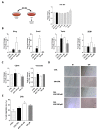High Adenosine Extracellular Levels Induce Glioblastoma Aggressive Traits Modulating the Mesenchymal Stromal Cell Secretome
- PMID: 33081024
- PMCID: PMC7589183
- DOI: 10.3390/ijms21207706
High Adenosine Extracellular Levels Induce Glioblastoma Aggressive Traits Modulating the Mesenchymal Stromal Cell Secretome
Abstract
Glioblastoma is an aggressive, fast-growing brain tumor influenced by the composition of the tumor microenvironment (TME) in which mesenchymal stromal cell (MSCs) play a pivotal role. Adenosine (ADO), a purinergic signal molecule, can reach up to high micromolar concentrations in TME. The activity of specific adenosine receptor subtypes on glioma cells has been widely explored, as have the effects of MSCs on tumor progression. However, the effects of high levels of ADO on glioma aggressive traits are still unclear as is its role in cancer cells-MSC cross-talk. Herein, we first studied the role of extracellular Adenosine (ADO) on isolated human U343MG cells as a glioblastoma cellular model, finding that at high concentrations it was able to prompt the gene expression of Snail and ZEB1, which regulate the epithelial-mesenchymal transition (EMT) process, even if a complete transition was not reached. These effects were mediated by the induction of ERK1/2 phosphorylation. Additionally, ADO affected isolated bone marrow derived MSCs (BM-MSCs) by modifying the pattern of secreted inflammatory cytokines. Then, the conditioned medium (CM) of BM-MSCs stimulated with ADO and a co-culture system were used to investigate the role of extracellular ADO in GBM-MSC cross-talk. The CM promoted the increase of glioma motility and induced a partial phenotypic change of glioblastoma cells. These effects were maintained when U343MG cells and BM-MSCs were co-cultured. In conclusion, ADO may affect glioma biology directly and through the modulation of the paracrine factors released by MSCs overall promoting a more aggressive phenotype. These results point out the importance to deeply investigate the role of extracellular soluble factors in the glioma cross-talk with other cell types of the TME to better understand its pathological mechanisms.
Keywords: adenosine; co-culture; glioblastoma; mesenchymal stromal cells; tumor microenvironment.
Conflict of interest statement
The authors declare no conflict of interest.
Figures






Similar articles
-
Extracellular adenosine oppositely regulates the purinome machinery in glioblastoma and mesenchymal stem cells.IUBMB Life. 2024 Dec;76(12):1234-1251. doi: 10.1002/iub.2905. Epub 2024 Aug 12. IUBMB Life. 2024. PMID: 39134088 Free PMC article.
-
Impact of mesenchymal stem cells' secretome on glioblastoma pathophysiology.J Transl Med. 2017 Oct 2;15(1):200. doi: 10.1186/s12967-017-1303-8. J Transl Med. 2017. PMID: 28969635 Free PMC article.
-
MiR-146b-5p suppresses the malignancy of GSC/MSC fusion cells by targeting SMARCA5.Aging (Albany NY). 2020 Jul 6;12(13):13647-13667. doi: 10.18632/aging.103489. Epub 2020 Jul 6. Aging (Albany NY). 2020. PMID: 32632040 Free PMC article.
-
Cross talk between mesenchymal and glioblastoma stem cells: Communication beyond controversies.Stem Cells Transl Med. 2020 Nov;9(11):1310-1330. doi: 10.1002/sctm.20-0161. Epub 2020 Jun 15. Stem Cells Transl Med. 2020. PMID: 32543030 Free PMC article. Review.
-
Similarities in Mechanisms of Ovarian Cancer Metastasis and Brain Glioblastoma Multiforme Invasion Suggest Common Therapeutic Targets.Cells. 2025 Jan 23;14(3):171. doi: 10.3390/cells14030171. Cells. 2025. PMID: 39936963 Free PMC article. Review.
Cited by
-
Exosomes: Small EVs with Large Immunomodulatory Effect in Glioblastoma.Int J Mol Sci. 2021 Mar 30;22(7):3600. doi: 10.3390/ijms22073600. Int J Mol Sci. 2021. PMID: 33808435 Free PMC article. Review.
-
Extracellular adenosine oppositely regulates the purinome machinery in glioblastoma and mesenchymal stem cells.IUBMB Life. 2024 Dec;76(12):1234-1251. doi: 10.1002/iub.2905. Epub 2024 Aug 12. IUBMB Life. 2024. PMID: 39134088 Free PMC article.
-
Engineering the glioblastoma microenvironment with bioactive nanoparticles for effective immunotherapy.RSC Adv. 2023 Oct 27;13(45):31411-31425. doi: 10.1039/d3ra01153d. eCollection 2023 Oct 26. RSC Adv. 2023. PMID: 37901257 Free PMC article. Review.
-
Mesenchymal-Stem-Cell-Based Therapy against Gliomas.Cells. 2024 Apr 2;13(7):617. doi: 10.3390/cells13070617. Cells. 2024. PMID: 38607056 Free PMC article. Review.
-
The Interplay between Glioblastoma and Its Microenvironment.Cells. 2021 Aug 31;10(9):2257. doi: 10.3390/cells10092257. Cells. 2021. PMID: 34571905 Free PMC article. Review.
References
-
- Zhang Q., Yi D.Y., Xue B.Z., Wen W.W., Lu Y.P., Abdelmaksou A., Sun M.X., Yuan D.T., Zhao H.Y., Xiong N.X., et al. CD90 determined two subpopulations of glioma-associated mesenchymal stem cells with different roles in tumour progression. Cell Death Dis. 2018;9:1101. doi: 10.1038/s41419-018-1140-6. - DOI - PMC - PubMed
MeSH terms
Substances
Grants and funding
LinkOut - more resources
Full Text Sources
Medical
Research Materials
Miscellaneous

